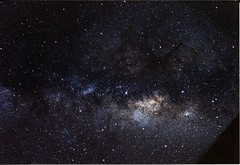
Milky Way
Originally uploaded by Astro Guy.
This has been a week of CPU busy time. Running lots of different models and generating lots of text output. That make a very boring blog entry. So I searched through some of my older photographs and I found this one I took while on an observing run in Mexico. I used 200 ISO film and strapped my camera to the side of the telescope and left the shutter open for about 10 minutes. I was quite excited to see this photo when I developed the film. This is a picture of the Milky Way - our own galaxy. So we are sorta looking at it inside out. The brightest patch in the photo is the direction towards the galactic centre. The dark patches that seem devoid of the stars is actually due to dust that obscures light in the optical part of the spectrum. It's not that there are not any stars there, we just can see them.
I was observing at San Pedro Martir, which is on the Baja California region of Mexico and I spent about 30 days at the summit. It's probably the best site I've been to - better than Hilo in my opinion. You can watch stars rise and set. Not just fade away into the hazy of the atmosphere low on the horizon, but disappear behind land. It was spectacual. You almost feel like the MilkyWay is the only light around you (which is not true..). Can't wait to go back.
The purpose of the observing run was to survey northern Ap stars for variability. To see if they are roAp (rapidilly oscillating) or noAp stars (no oscillations). Currently, almost all roAp stars are found at southern declinations. Everyone seems to believe this is just an observational bias, but every northern survey comes up blank. It's very odd.
roAp stars are known to have pulsation modulation (in FT space you see a spacing of very close frequencies). The model to explain this is called the oblique rotator, where the rotation axis is different from the pulsation axis. Since the non-radial modes are sequencial, the pulsation pattern appears skewed to one pole. As the star rotates this pole will go in and out of view causing the amplitudes of the pulsations to change. I made a movie to show this effect:
roAp Star Movie
The sound is actually from light curve data from an observed roAp star that I've tried to sync up with the movie. It's close, but not bad.
Anyways, with rotation (and magnetic fields!!) one could easily observing stars during pulsation minimum and not pickup the small photometric variations (tenths of a millimag and smaller!). It's a project that just takes patience and lots of telescope time. If it turns out that roAp stars are preferentially found in the South, then the fun begins of explain why!
No comments:
Post a Comment